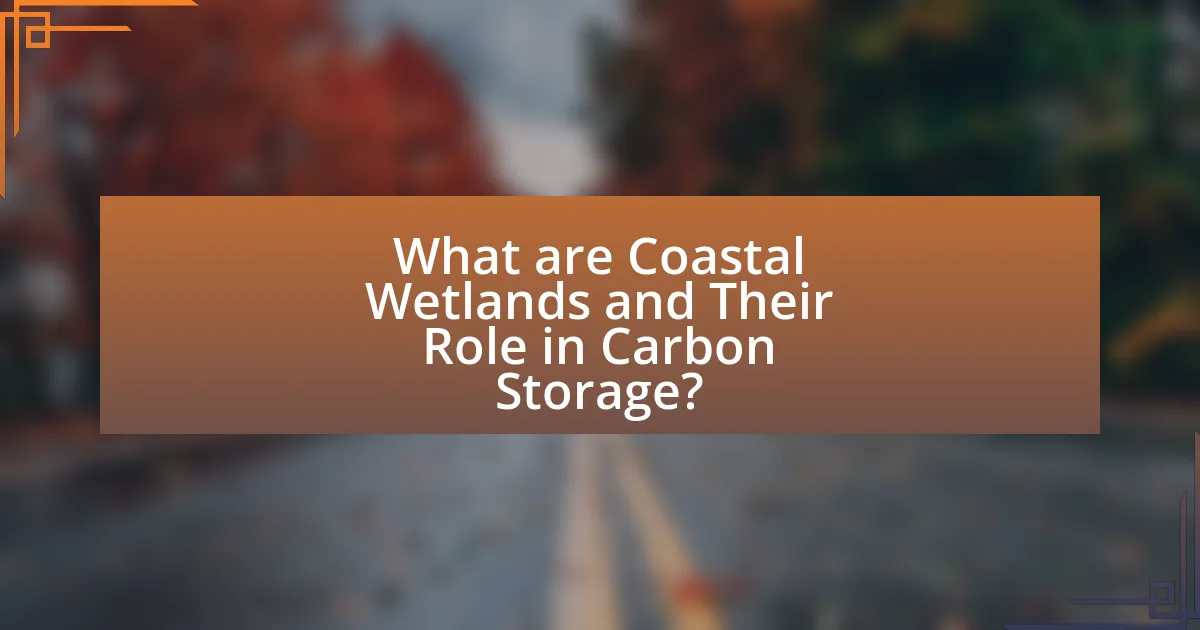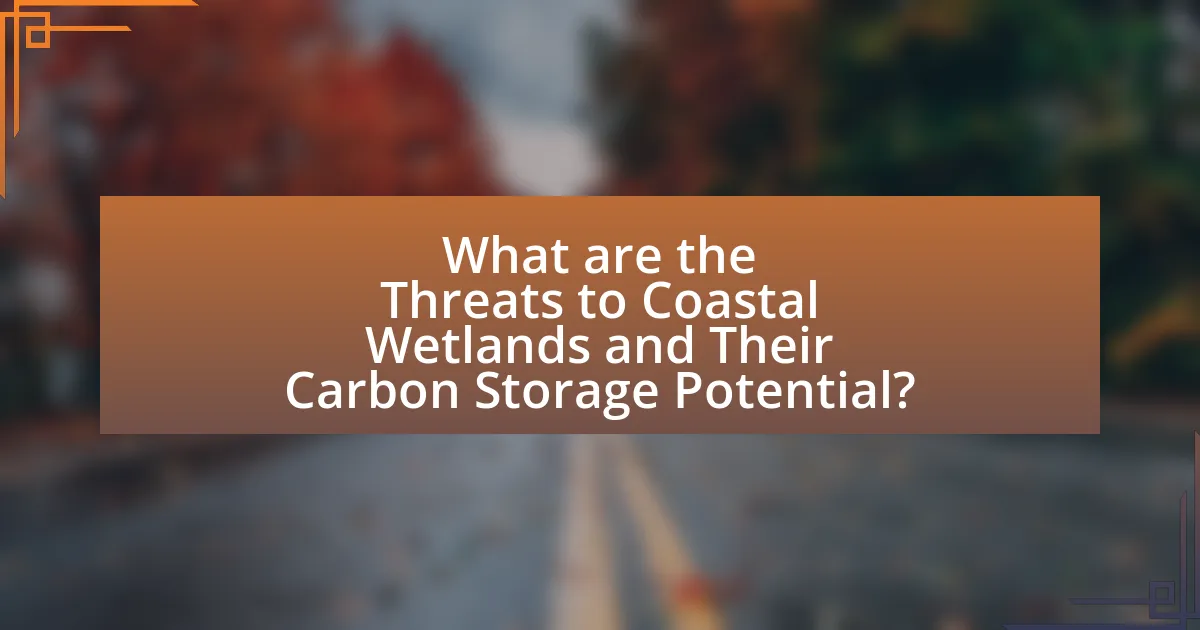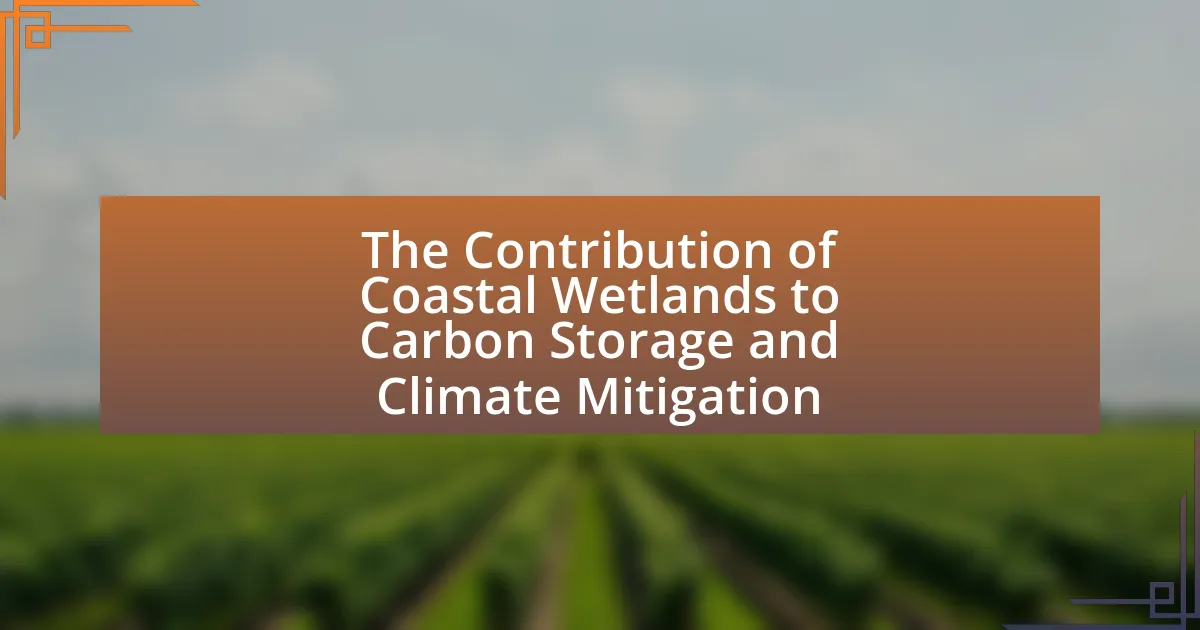Coastal wetlands, including marshes, mangroves, and seagrasses, are vital ecosystems that significantly contribute to carbon storage and climate mitigation. These areas sequester carbon dioxide at rates up to 50 times greater than terrestrial forests, playing a crucial role in reducing greenhouse gas emissions and enhancing resilience against climate change impacts. The article explores the processes involved in carbon storage within coastal wetlands, the threats they face from human activities and natural disasters, and strategies for their restoration and conservation. It emphasizes the importance of community engagement and educational initiatives in supporting the preservation of these ecosystems, which are essential for maintaining ecological balance and combating climate change.

What are Coastal Wetlands and Their Role in Carbon Storage?
Coastal wetlands are ecosystems located at the interface of land and water, including marshes, mangroves, and seagrasses, which play a crucial role in carbon storage. These ecosystems sequester carbon dioxide from the atmosphere through the process of photosynthesis and store it in their biomass and sediments, effectively mitigating climate change. Research indicates that coastal wetlands can store up to 50 times more carbon per unit area than terrestrial forests, highlighting their significance in global carbon cycles. Additionally, the World Resources Institute reports that protecting and restoring coastal wetlands could prevent the release of significant amounts of carbon currently stored in these environments, further emphasizing their importance in climate mitigation strategies.
How do Coastal Wetlands contribute to Carbon Sequestration?
Coastal wetlands contribute to carbon sequestration by capturing and storing carbon dioxide from the atmosphere in their plant biomass and sediment. These ecosystems, including mangroves, salt marshes, and seagrasses, have high productivity and can accumulate organic matter at rates significantly higher than terrestrial forests. For instance, a study published in “Nature” by Mcleod et al. (2011) indicates that coastal wetlands can sequester carbon at rates of up to 10 times greater than terrestrial forests, effectively storing large amounts of carbon in their soils. This process not only mitigates climate change by reducing atmospheric CO2 levels but also enhances the resilience of coastal areas against sea-level rise and erosion.
What processes are involved in Carbon Storage within Coastal Wetlands?
Carbon storage within coastal wetlands involves several key processes, including primary production, organic matter accumulation, and sediment trapping. Primary production occurs as plants, particularly salt marsh grasses and mangroves, photosynthesize and convert carbon dioxide into organic material. This organic matter accumulates in the soil as plant debris decomposes slowly in waterlogged conditions, leading to significant carbon sequestration. Additionally, coastal wetlands trap sediments carried by water, which can bury organic carbon and further enhance carbon storage. Studies indicate that coastal wetlands can sequester carbon at rates up to 10 times greater than terrestrial forests, highlighting their critical role in climate mitigation.
How do different types of Coastal Wetlands vary in their Carbon Storage capabilities?
Different types of coastal wetlands exhibit significant variations in their carbon storage capabilities, primarily influenced by their vegetation types, hydrology, and sediment characteristics. For instance, mangrove forests are known to sequester carbon at rates of up to 1,000 grams of carbon per square meter per year due to their dense root systems and anaerobic conditions that slow down decomposition. In contrast, salt marshes typically store carbon at lower rates, around 200 to 500 grams per square meter per year, but they still play a crucial role in carbon cycling due to their extensive coverage and ability to trap sediments. Additionally, seagrass meadows can sequester carbon at rates of approximately 100 to 200 grams per square meter per year, contributing to long-term carbon storage in their sediments. These differences highlight the importance of preserving diverse coastal wetland types to maximize their carbon storage potential and mitigate climate change impacts.
Why are Coastal Wetlands important for Climate Mitigation?
Coastal wetlands are crucial for climate mitigation because they act as significant carbon sinks, sequestering large amounts of carbon dioxide from the atmosphere. Research indicates that coastal wetlands, such as mangroves, salt marshes, and seagrasses, can store up to 10 times more carbon per unit area than terrestrial forests. This high carbon storage capacity is due to their unique anaerobic conditions, which slow down the decomposition of organic matter, allowing carbon to accumulate over time. Additionally, coastal wetlands help reduce greenhouse gas emissions by filtering pollutants and enhancing water quality, further contributing to climate resilience.
What role do Coastal Wetlands play in reducing greenhouse gas emissions?
Coastal wetlands play a crucial role in reducing greenhouse gas emissions by acting as significant carbon sinks. These ecosystems sequester carbon dioxide from the atmosphere through the process of photosynthesis and store it in plant biomass and sediment. Research indicates that coastal wetlands, such as mangroves, salt marshes, and seagrasses, can sequester carbon at rates up to 10 times higher than terrestrial forests. This high rate of carbon storage is due to the anaerobic conditions in waterlogged soils, which slow down the decomposition of organic matter, thereby preventing the release of stored carbon back into the atmosphere.
How do Coastal Wetlands enhance resilience against climate change impacts?
Coastal wetlands enhance resilience against climate change impacts by acting as natural buffers that absorb storm surges, reduce flooding, and stabilize shorelines. These ecosystems, including mangroves, salt marshes, and seagrasses, can sequester significant amounts of carbon, thereby mitigating greenhouse gas emissions. For instance, a study published in “Nature Climate Change” by Mcleod et al. (2011) found that coastal wetlands can store up to 50 times more carbon per unit area than terrestrial forests, highlighting their critical role in climate regulation. Additionally, their ability to filter pollutants and improve water quality further supports ecosystem health, making coastal wetlands vital for adapting to and mitigating the effects of climate change.

What are the Threats to Coastal Wetlands and Their Carbon Storage Potential?
Coastal wetlands face significant threats that undermine their carbon storage potential, primarily due to climate change, urban development, pollution, and invasive species. Climate change leads to rising sea levels and increased salinity, which can degrade wetland ecosystems and reduce their ability to sequester carbon. Urban development often results in habitat loss and fragmentation, further diminishing the wetlands’ capacity to store carbon. Pollution from agricultural runoff and industrial discharges introduces harmful substances that can disrupt the biological processes essential for carbon storage. Additionally, invasive species can outcompete native vegetation, altering the ecosystem dynamics and negatively impacting carbon sequestration. These factors collectively threaten the integrity and functionality of coastal wetlands, which are crucial for climate mitigation efforts.
How do human activities impact Coastal Wetlands?
Human activities significantly impact coastal wetlands through pollution, habitat destruction, and climate change. Pollution from agricultural runoff and urban development introduces harmful chemicals and nutrients, leading to eutrophication and degradation of wetland ecosystems. Habitat destruction occurs due to coastal development, such as construction and land reclamation, which reduces the area available for wetlands and disrupts their natural functions. Additionally, climate change, driven by human activities, results in rising sea levels and increased storm intensity, further threatening the stability and health of coastal wetlands. These impacts compromise the wetlands’ ability to store carbon, which is crucial for climate mitigation, as they are among the most effective ecosystems for carbon sequestration.
What are the effects of urban development on Coastal Wetlands?
Urban development negatively impacts coastal wetlands by leading to habitat loss, increased pollution, and altered hydrology. The construction of infrastructure and residential areas often results in the direct destruction of wetland ecosystems, which are crucial for biodiversity and carbon storage. For instance, studies indicate that urbanization can reduce wetland area by up to 50%, significantly diminishing their capacity to sequester carbon. Additionally, urban runoff introduces pollutants such as nutrients and heavy metals into wetlands, further degrading their ecological functions. Altered water flow due to urban development can disrupt the natural hydrology of wetlands, affecting their ability to filter water and store carbon effectively.
How does pollution affect the Carbon Storage capacity of Coastal Wetlands?
Pollution significantly reduces the carbon storage capacity of coastal wetlands. Contaminants such as heavy metals, nutrients, and organic pollutants disrupt the biological processes essential for carbon sequestration. For instance, excess nutrients from agricultural runoff can lead to eutrophication, which diminishes the health of wetland vegetation, thereby impairing its ability to capture and store carbon. Studies indicate that polluted wetlands can lose up to 50% of their carbon storage potential compared to unpolluted counterparts, highlighting the critical impact of pollution on these ecosystems’ roles in climate mitigation.
What natural threats do Coastal Wetlands face?
Coastal wetlands face several natural threats, including sea-level rise, storm surges, and erosion. Sea-level rise, driven by climate change, can inundate these ecosystems, leading to habitat loss and decreased biodiversity. Storm surges from hurricanes and severe weather events can cause significant physical damage to wetland structures, while erosion can result in the gradual loss of land and the essential functions these wetlands provide, such as carbon storage and flood protection. According to the National Oceanic and Atmospheric Administration (NOAA), coastal wetlands are projected to decline by 30-50% by the end of the century due to these threats, highlighting their vulnerability and the urgent need for conservation efforts.
How do climate change and sea-level rise threaten Coastal Wetlands?
Climate change and sea-level rise threaten coastal wetlands by increasing salinity, altering hydrology, and causing habitat loss. As global temperatures rise, sea levels are projected to increase by 0.3 to 1.2 meters by 2100, inundating low-lying wetlands and reducing their area. This inundation leads to higher salinity levels, which can adversely affect freshwater species and disrupt the ecological balance. Additionally, changes in precipitation patterns can alter the natural water flow, further stressing these ecosystems. Studies indicate that coastal wetlands are vital for carbon storage, sequestering approximately 1.5 billion tons of carbon annually; their degradation due to climate change could release significant amounts of stored carbon, exacerbating climate change.
What are the implications of natural disasters on Coastal Wetlands’ Carbon Storage?
Natural disasters significantly disrupt coastal wetlands’ carbon storage capabilities. Events such as hurricanes, floods, and sea-level rise can lead to the erosion of wetland areas, resulting in the release of stored carbon into the atmosphere. For instance, a study published in the journal “Nature Climate Change” indicates that hurricanes can cause substantial loss of vegetation, which is crucial for carbon sequestration, thereby diminishing the wetlands’ ability to store carbon effectively. Additionally, the physical disturbance from these disasters can alter sediment dynamics, further impacting the wetlands’ ecological balance and their long-term carbon storage potential.

What Strategies Can Enhance the Carbon Storage Capacity of Coastal Wetlands?
Strategies that can enhance the carbon storage capacity of coastal wetlands include restoring degraded wetlands, implementing sustainable land-use practices, and promoting the growth of native vegetation. Restoring degraded wetlands can significantly increase carbon sequestration, as healthy wetlands can store up to 1,000 tons of carbon per hectare over a century. Sustainable land-use practices, such as reducing nutrient runoff and controlling invasive species, help maintain the ecological balance necessary for optimal carbon storage. Additionally, promoting the growth of native vegetation, which is better adapted to local conditions, can enhance biomass accumulation and soil organic carbon levels, further contributing to carbon storage.
How can restoration efforts improve Coastal Wetlands’ Carbon Sequestration?
Restoration efforts can significantly improve coastal wetlands’ carbon sequestration by enhancing the growth of vegetation and restoring hydrological processes. Healthy coastal wetlands, such as mangroves and salt marshes, are capable of capturing and storing large amounts of carbon dioxide through photosynthesis and sediment accumulation. For instance, a study published in “Nature Climate Change” by M. A. Spalding et al. (2014) indicates that mangroves can sequester carbon at rates of up to 1,000 tons per hectare over a 20-year period. By re-establishing native plant species and improving water flow, restoration projects can increase biomass and soil organic carbon, thereby boosting the overall carbon storage capacity of these ecosystems.
What best practices are effective in restoring Coastal Wetlands?
Effective best practices for restoring coastal wetlands include re-establishing natural hydrology, planting native vegetation, and controlling invasive species. Re-establishing natural hydrology involves restoring water flow patterns to mimic historical conditions, which is crucial for maintaining the ecological balance and supporting diverse habitats. Planting native vegetation enhances biodiversity and stabilizes soil, while controlling invasive species prevents them from outcompeting native flora, thereby promoting a healthy ecosystem. Research indicates that these practices significantly improve carbon sequestration capabilities of coastal wetlands, contributing to climate mitigation efforts. For instance, a study published in “Nature Climate Change” by M. A. Spalding et al. highlights that restored wetlands can sequester carbon at rates comparable to or exceeding those of intact ecosystems.
How do conservation policies support the preservation of Coastal Wetlands?
Conservation policies support the preservation of coastal wetlands by implementing regulations that protect these ecosystems from degradation and loss. These policies often include designating protected areas, enforcing sustainable land-use practices, and providing funding for restoration projects. For instance, the U.S. National Oceanic and Atmospheric Administration (NOAA) has established programs that allocate resources for the restoration of coastal habitats, which are crucial for carbon storage and climate mitigation. Additionally, studies indicate that well-managed coastal wetlands can sequester up to 1.5 billion metric tons of carbon annually, highlighting the effectiveness of conservation policies in maintaining these vital ecosystems.
What role does community engagement play in Coastal Wetland conservation?
Community engagement plays a crucial role in Coastal Wetland conservation by fostering local stewardship and enhancing the effectiveness of conservation efforts. Engaged communities are more likely to participate in restoration projects, monitor wetland health, and advocate for sustainable practices, which directly contributes to the preservation of these ecosystems. Studies have shown that when local stakeholders are involved, conservation initiatives are more successful; for instance, a report by the National Oceanic and Atmospheric Administration highlights that community-led projects in coastal areas have led to a 30% increase in wetland restoration success rates. This active participation not only empowers communities but also ensures that conservation strategies are culturally relevant and economically viable, ultimately supporting the broader goals of carbon storage and climate mitigation.
How can local communities contribute to the protection of Coastal Wetlands?
Local communities can contribute to the protection of coastal wetlands by engaging in sustainable practices, advocating for conservation policies, and participating in restoration projects. These actions help maintain the ecological balance and enhance the carbon storage capacity of wetlands, which is crucial for climate mitigation. For instance, community-led initiatives such as mangrove planting have been shown to increase carbon sequestration rates significantly, with studies indicating that mangroves can store up to four times more carbon than terrestrial forests. Additionally, local knowledge and stewardship can lead to better management of wetland resources, ensuring their health and resilience against climate change impacts.
What educational initiatives can raise awareness about the importance of Coastal Wetlands?
Educational initiatives that can raise awareness about the importance of coastal wetlands include community workshops, school programs, and public awareness campaigns. Community workshops can provide hands-on experiences and expert-led discussions that highlight the ecological and economic benefits of coastal wetlands, such as their role in carbon storage and climate mitigation. School programs can integrate coastal wetland education into science curricula, fostering early awareness among students about their significance in biodiversity and climate resilience. Public awareness campaigns utilizing social media, informational brochures, and local events can effectively disseminate knowledge to a broader audience, emphasizing the critical functions of coastal wetlands in carbon sequestration, as evidenced by studies showing that coastal wetlands can store up to 50 times more carbon per unit area than terrestrial forests.
What are practical steps for individuals to support Coastal Wetland conservation?
Individuals can support Coastal Wetland conservation by participating in local restoration projects, advocating for policy changes, and reducing their carbon footprint. Engaging in community clean-up events helps remove debris that can harm wetland ecosystems, while supporting legislation aimed at protecting these areas ensures long-term conservation efforts. Additionally, individuals can minimize their carbon emissions by using public transportation, reducing plastic use, and supporting sustainable practices, which collectively contribute to the health of coastal wetlands. Studies indicate that healthy coastal wetlands can sequester up to 50 times more carbon than terrestrial forests, highlighting the importance of individual actions in preserving these vital ecosystems.
